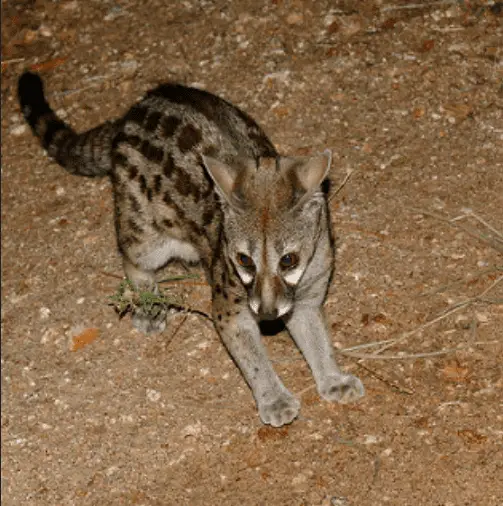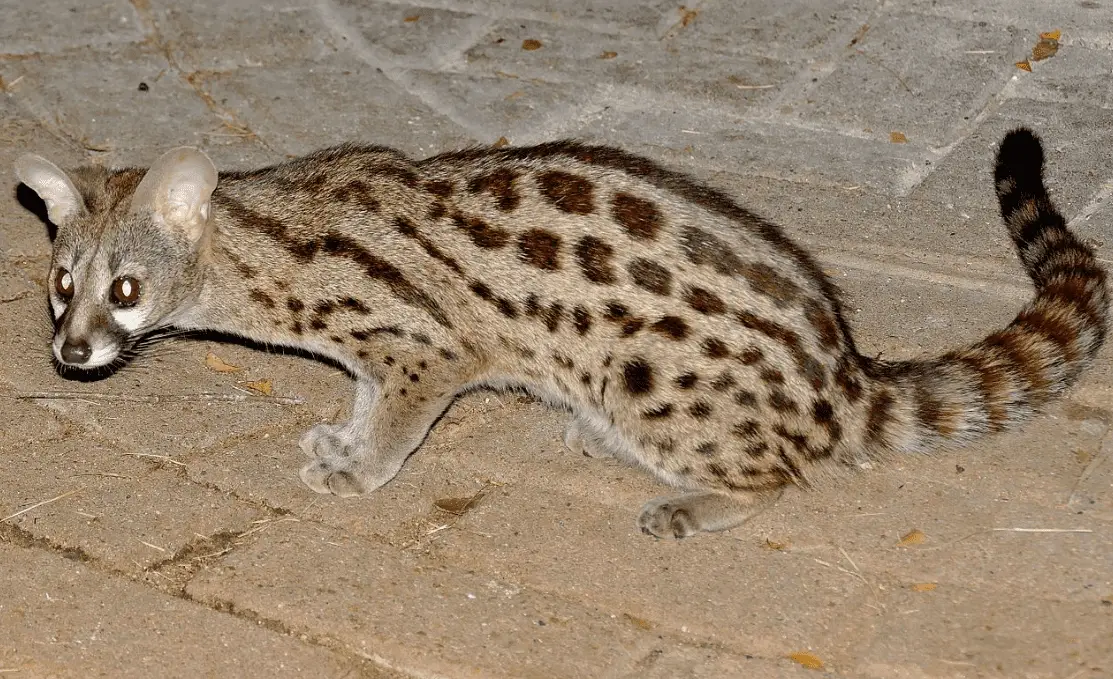Table of Contents
*This post may contain affiliate links. As an Amazon Associate we earn from qualifying purchases.
Q&A: Spotted Genet Traits and Pet Ownership
The spotted genet goes by a few different names including the common genet, Ibiza common genet, and its binomial name Genetta genetta. It’s a type of vererrid, which is a small-to-medium-sized mammal that is closely related to the mongoose but looks like a cross between a raccoon and a leopard.
The spotted genet has the spots of the leopard on its body and sports a striped raccoon-like tail. Because of its tiny size and big round eyes, the genet would never be mistaken for either of them out in the wild, nor should it be identified as a cat. The spotted genet population numbers are healthy, so they are not an endangered species.
What Is a Spotted Genet?

The terms “small-spotted genet” and “large-spotted genet” refer to the size of their spots and not the body size, though there are smaller and larger versions of the species. In fact, there are over 30 different kinds of genets. They do have many similarities, though:
- arrow-right
- arrow-right
- arrow-right
- arrow-right
- arrow-right
- arrow-right
- arrow-right
- arrow-right
- arrow-right
How Does the Genet Behave in the Wild?
You can find spotted genets in the wild throughout parts of Africa and the Mediterranean. Animal traders introduced the genet in Europe, so they can now be located in Switzerland, Spain, Belgium, Portugal, Germany, southern France and northern Italy. The animals prefer wooded areas with lots of vegetation for protection and small animals for food.
Their dens can be found in rocky areas and holes in the ground. They prefer to be independent and often hunt alone at night. Their territories can overlap, but they only interact during mating season, which runs from January through September with the most mating activity between February and March.
Once female genets reach 2 years old, they can have two litters per year of up to four offspring. The gestation period is about two and a half months long. The babies stay with the mother in the den for the first month and a half and begin to hunt and eat meat for around seven weeks.
However, they continue taking milk from their mom for the first few months even after they start to eat solid food. In general, wild genets have shorter life spans than genets kept as pets. With proper nutrition and veterinarian care, a domesticated genet can live approximately 13 years compared to eight for the wild genet.
What Does the Genet Eat in the Wild?
Spotted genets are carnivores and like to eat small mammals such as mice. However, they also will eat any small creatures that they can catch, including bats, birds, and reptiles. Insects make up another part of their food chain.
The large-spotted genets eat more fruit than the small-spotted ones. They can be excellent animals to have near human settlements, as they eat many of the small pests that plague crops.
What Does the Genet Sound Like?
Genets are known to have a variety of different situation-specific vocalizations:
- arrow-right
- arrow-right
- arrow-right
Who Hunts the Spotted Genet?
Genets don’t have many predators, but a few notable ones stand out:
- arrow-right
Do Spotted Genets Make Good Pets?
Many people have started keeping spotted genets as exotic pets. If you are thinking of doing this, you should do extensive research before purchasing one to ensure the animal is a good fit for your lifestyle and your ability to care for it properly.
You will also want to check with your local and state government regarding regulations in owning exotic pets. Some states have more regulations than others, and some exotic animals are illegal to own.
Genets can be friendly with those who take care of them most frequently, but they are not cuddly lap pets. So, if you are expecting to snuggle with a genet the way you do with a friendly dog or cat, you will likely be disappointed. Genets usually have standoffish personalities and may decide to perch on your shoulder when the desire strikes them. Otherwise, genets prefer to do their own thing.
Early socialization is key to a well-adjusted genet, but even then, the animal will probably run off and hide at the first sight or sound of trouble. This flight response is coded into genets’ DNA, and it is important to remember that they are wild animals.
Compared to other animals that have been domesticated over centuries, such as dogs, cats, and horses, spotted genets are relatively new household pets that may not acclimate to being pets just because you put them in your house. Unless you have extensive experience with exotic animals or difficult pets, you may want to reconsider bringing one home.
What Does the Spotted Genet Eat as a Pet?
While genets have qualities of felines, they are not cats and should not only be fed cat food. Like wild animals, they still require food they would find out in the wild, which can be purchased at reptile food supply stores. Frozen game meat can keep their teeth and bodies healthy.
Consider feeding a high-quality cat or ferret food along with small mammals or reptiles. Adding organ meats that you can find at the butcher shop and vegetables will round out the genet’s diet. You should strive to keep the food low in carbohydrates and high in taurine.
How Much Does a Pet Genet Cost?
Genets are expensive pets. The initial cost could be up to $1500 from a local breeder and higher if you purchase the animal from a non-local breeder due to shipping costs. Owners attempting to re-home their genets may be trying to pass on problematic animals with behavioral problems. Therefore, you should either purchase from a reputable breeder or make sure that you are prepared to care for the animal if it has issues. The more homes animals go through, the more behavior problems they will likely have. It can be unfair to the animals when their owners do not have the knowledge to properly care for them and quickly grow tired of their behavior.
After purchase, genets need to be seen by veterinarians with exotic animal specialties who can provide vaccinations such as rabies and distemper and keep them in overall good health. You may have difficulty finding a veterinarian who knows about spotted genets, especially if you live in a rural area. Since most standard vaccines are not meant for genets, there is no guarantee that they will work or that you will be legally protected if your genet bites someone.
Who Else Owns a Spotted Genet?
If you are going to purchase a genet, then the best way to properly care for it is to get in touch with a community of like-minded people. Thankfully, the internet makes it much easier to do this than ever before. Find and join a community where you can ask questions and receive help for problem behavior. The more people that work together to solve problems, the easier pet ownership can be. You can find out more about feeding requirements, problem behavior, veterinarian costs, and the laws regarding ownership of exotic animals in your area.

Conclusion
The spotted genet comes in a small-spotted and large-spotted version with slight differences between the two, and there are over 30 different kinds of genets. As nocturnal animals, they hunt small animals at night and sleep during the day. They are aloof creatures with distinct markings, and they most resemble a mongoose. Spotted genets do not generally make good pets, but some people have started keeping them in the home. Like cats, they can spray to mark their territory, which can make owners unhappy. Their most helpful trait is keeping pest rodent populations in check. It’s probably best to let the genets live in the wild, read about them or watch videos on their behavior, and visit one in a nearby zoo.
Featured image credit: CC by SA, Bernard DUPONT, via Flickr.com.

